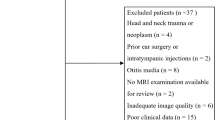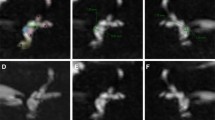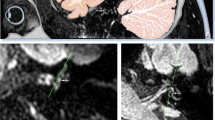Abstract
Objectives
A case-controlled imaging study demonstrated that saccular hydrops was specific to Meniere’s disease (MD), but only present in a subset of patients. Here, we compared patients with definite MD, vertigo and sensorineural hearing loss (SNHL) to elucidate the relationship between saccular hydrops and extent of SNHL.
Methods
In this prospective study, we performed 3D-FLAIR sequences between 4.5 and 5.5 h after contrast media injection in patients with MD (n=20), SNHL (n=20), vertigo (n=20) and 30 healthy subjects. Two radiologists independently graded saccular hydrops. ROC analysis was performed to determine the hearing loss threshold to differentiate patients with saccular hydrops.
Results
Saccular hydrops was found in 11 of 20 MD patients, 10 of 20 SNHL patients and in none of the vertigo patients and healthy subjects. In SNHL patients, 45 dB was the threshold above which there was a significant association with saccular hydrops, with sensitivity of 100 % and specificity of 90 %. In MD patients, 40 dB was the threshold above which there was a significant association with saccular hydrops, with sensitivity of 100 % and specificity of 44 %.
Conclusions
Our results indicate saccular hydrops as a feature of worse than moderate SNHL rather than MD itself.
Key Points
• MRI helps clinicians to assess patients with isolated low-tone sensorineural hearing loss.
• Saccular hydrops correlates with sensorineural hearing loss at levels above 40 dB.
• Vertigo patients without sensorineural hearing loss do not have saccular hydrops.
• Saccular hydrops is described in patients without clinical diagnosis of Meniere’s disease.




Similar content being viewed by others
Abbreviations
- ESS:
-
Endolymphatic sac surgery
- MD:
-
Meniere’s disease
- SNHL:
-
Sensorineural hearing loss
- SURI:
-
Saccule to Utricle Ratio Inversion
References
Altmann F (1949) Surgical treatment of Ménière’s disease. The Laryngoscope 59:1045–1067
Kimura RS (1982) Animal models of endolymphatic hydrops. Am J Otolaryngol 3:447–451
Nakashima T, Naganawa S, Pyykko I, et al (2009) Grading of endolymphatic hydrops using magnetic resonance imaging. Acta Oto-Laryngol Suppl 5–8. https://doi.org/10.1080/00016480902729827
Yoshida T, Sugimoto S, Teranishi M, et al (2017) Imaging of the endolymphatic space in patients with Ménière’s disease. Auris Nasus Larynx. https://doi.org/10.1016/j.anl.2017.02.002
Attyé A, Dumas G, Troprès I et al (2015) Recurrent peripheral vestibulopathy: Is MRI useful for the diagnosis of endolymphatic hydrops in clinical practice? Eur Radiol 25:3043–3049
Baráth K, Schuknecht B, Naldi AM et al (2014) Detection and grading of endolymphatic hydrops in Menière disease using MR imaging. AJNR Am J Neuroradiol 35:1387–1392
Bykowski J, Harris JP, Miller M et al (2015) Intratympanic Contrast in the Evaluation of Menière Disease: Understanding the Limits. AJNR Am J Neuroradiol 36:1326–1332
Eliezer M, Gillibert A, Tropres I, et al Influence of inversion time on endolymphatic hydrops evaluation in 3D-FLAIR imaging. J Neuroradiol. https://doi.org/10.1016/j.neurad.2017.06.002
Pender DJ (2014) Endolymphatic hydrops and Ménière’s disease: a lesion meta-analysis. J Laryngol Otol 128:859–865
Rauch SD, Merchant SN, Thedinger BA (1989) Meniere’s syndrome and endolymphatic hydrops. Double-blind temporal bone study. Ann Otol Rhinol Laryngol 98:873–883
Attyé A, Eliezer M, Boudiaf N, et al (2016) MRI of endolymphatic hydrops in patients with Meniere’s disease: a case-controlled study with a simplified classification based on saccular morphology. Eur Radiol. https://doi.org/10.1007/s00330-016-4701-z
Sajjadi H, Paparella MM (2008) Meniere’s disease. Lancet 372:406–414
(1995) Committee on Hearing and Equilibrium guidelines for the diagnosis and evaluation of therapy in Menière’s disease. American Academy of Otolaryngology-Head and Neck Foundation, Inc. Otolaryngol--Head Neck Surg Off J Am Acad Otolaryngol-Head Neck Surg 113:181–185
Lopez-Escamez JA, Carey J, Chung W-H et al (2015) Diagnostic criteria for Menière’s disease. J Vestib Res Equilib Orientat 25:1–7
Morita N, Kariya S, Farajzadeh Deroee A et al (2009) Membranous labyrinth volumes in normal ears and Ménière disease: a three-dimensional reconstruction study. The Laryngoscope 119:2216–2220
Landis JR, Koch GG (1977) The measurement of observer agreement for categorical data. Biometrics 33:159–174
Miller MW, Agrawal Y (2014) Intratympanic Therapies for Menière’s disease. Curr Otorhinolaryngol Rep 2:137–143
Paparella MM (2006) Endolymphatic sac revision for recurrent intractable Meniere’s disease. Otolaryngol Clin North Am 39:713–721 vi
Sood AJ, Lambert PR, Nguyen SA, Meyer TA (2014) Endolymphatic sac surgery for Ménière’s disease: a systematic review and meta-analysis. Otol Neurotol Off Publ Am Otol Soc Am Neurotol Soc Eur Acad Otol Neurotol 35:1033–1045
Thomsen J, Bretlau P, Tos M, Johnsen NJ (1981) Placebo effect in surgery for Ménière’s disease. A double-blind, placebo-controlled study on endolymphatic sac shunt surgery. Arch Otolaryngol Chic Ill 1960 107:271–277
Kitahara T, Fukushima M, Uno A et al (2013) Long-term results of endolymphatic sac drainage with local steroids for intractable Meniere’s disease. Auris Nasus Larynx 40:425–430
Durland WF, Pyle GM, Connor NP (2005) Endolymphatic sac decompression as a treatment for Meniere’s disease. The Laryngoscope 115:1454–1457
Hu A, Parnes LS (2010) 10-year review of endolymphatic sac surgery for intractable meniere disease. J Otolaryngol - Head Neck Surg J Oto-Rhino-Laryngol Chir Cervico-Faciale 39:415–421
Kimura RS, Schuknecht HF (1975) Effect of fistulae on endolymphatic hydrops. Ann Otol Rhinol Laryngol 84:271–286
Attyé A, Eliezer M, Galloux A, et al (2017) Endolymphatic hydrops imaging: differential diagnosis in patients with Meniere disease symptoms. Diagn Interv Imaging. https://doi.org/10.1016/j.diii.2017.06.002
Gürkov R, Flatz W, Ertl-Wagner B, Krause E (2013) Endolymphatic hydrops in the horizontal semicircular canal: a morphologic correlate for canal paresis in Ménière’s disease. The Laryngoscope 123:503–506
Pender DJ (2015) Membrane stress in the human labyrinth and Meniere disease: a model analysis. Int Arch Otorhinolaryngol 19:336–342
de Waele C, Tran Ba Huy P, Diard JP et al (1999) Saccular dysfunction in Ménière’s patients. A vestibular-evoked myogenic potential study. Ann N Y Acad Sci 871:392–397
Sepahdari AR, Ishiyama G, Vorasubin N et al (2015) Delayed intravenous contrast-enhanced 3D FLAIR MRI in Meniere’s disease: correlation of quantitative measures of endolymphatic hydrops with hearing. Clin Imaging 39:26–31
Salt AN, Plontke SK (2010) Endolymphatic hydrops: pathophysiology and experimental models. Otolaryngol Clin North Am 43:971–983
Merchant SN, Adams JC, Nadol JB (2005) Pathophysiology of Meniere’s syndrome: are symptoms caused by endolymphatic hydrops? Otol Neurotol Off Publ Am Otol Soc Am Neurotol Soc Eur Acad Otol Neurotol 26:74–81
Flock A, Flock B (2003) Micro-lesions in Reissner’s membrane evoked by acute hydrops. Audiol Neurootol 8:59–69
Samy RN, Houston L, Scott M et al (2015) Cochlear implantation in patients with Meniere’s disease. Cochlear Implants Int 16:208–212
Mick P, Amoodi H, Arnoldner C et al (2014) Cochlear implantation in patients with advanced Ménière’s disease. Otol Neurotol Off Publ Am Otol Soc Am Neurotol Soc Eur Acad Otol Neurotol 35:1172–1178
McRackan TR, Gifford RH, Kahue CN et al (2014) Cochlear implantation in Ménière’s disease patients. Otol Neurotol Off Publ Am Otol Soc Am Neurotol Soc Eur Acad Otol Neurotol 35:421–425
Gürkov R, Berman A, Dietrich O et al (2015) MR volumetric assessment of endolymphatic hydrops. Eur Radiol 25:585–595
Acknowledgements
The authors acknowledge the valuable assistance of Patrice Jousse and Hélène Fournié for their work in editing the MRI pictures and drawings. We also thank Dr Alison Foote (Grenoble Alps University Hospital) for critically reviewing the manuscript.
Funding
IRMaGe MRI/Neurophysiology facility was partly funded by the French program “Investissement d’Avenir” run by the “Agence Nationale pour la Recherche”; grant “Infrastructure d’avenir en Biologie Santé” - ANR-11-INBS-0006. This study was also partly funded by Guerbet SA for MRI in healthy volunteers.
Author information
Authors and Affiliations
Corresponding author
Ethics declarations
Guarantor
The scientific guarantor of this publication is Arnaud Attyé.
Conflict of interest
The authors of this manuscript declare no relationships with any companies whose products or services may be related to the subject matter of the article.
Statistics and biometry
One of the authors (Maud Medici) has significant statistical expertise.
Informed consent
Written informed consent was obtained from all subjects (patients) in this study.
Ethical approval
Institutional Review Board approval was obtained.
Study subjects or cohorts overlap
Some study healthy subjects have been previously reported in European Radiology (https://www.ncbi.nlm.nih.gov/pubmed/27999985).
Methodology
• prospective
• case-control study
• performed at one institution
Rights and permissions
About this article
Cite this article
Attyé, A., Eliezer, M., Medici, M. et al. In vivo imaging of saccular hydrops in humans reflects sensorineural hearing loss rather than Meniere’s disease symptoms . Eur Radiol 28, 2916–2922 (2018). https://doi.org/10.1007/s00330-017-5260-7
Received:
Revised:
Accepted:
Published:
Issue Date:
DOI: https://doi.org/10.1007/s00330-017-5260-7




